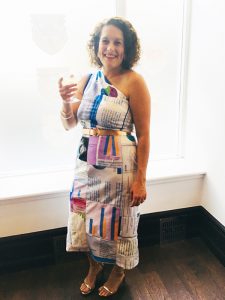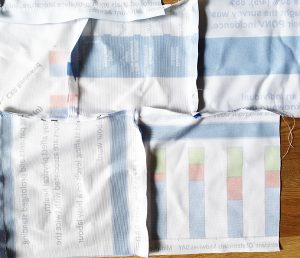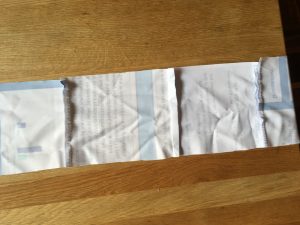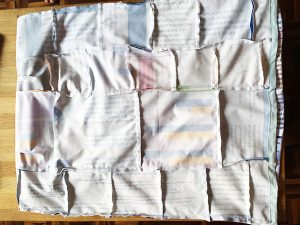Working for a medical organisation that holds several conferences a year I’m often in need of black tie attire and this month I decided to make a dress out of abandoned fabric printed scientific posters. Quite fairly my colleagues were a little dubious about how I was going to pull it off, and to be honest so was I! I don’t have any photos of the original posters but basically, they’re A1 sized posters covered in text, graphs and graphics about a medical research topic.

I decided to go for a simple fitted shift dress and use a pattern I’d used before to keep some of the complexity out of the project. Butterick 6582 (available here) is one of my favourite patterns. I went with dress B which only comprises of three pattern pieces for the body – one for the front and two pieces for the back. As it’s a dress I’m unlikely to ever wear again and there was enough give in the fabric, I cheated and didn’t add a zip. I also altered the pattern from having two shoulders to just one, which I thought gave it more of a cocktail dress look. I used a light weight cotton for the interfacing, which I lazily finished with pinking sheers rather than hemming.

In order to keep the posters obscure to start I cut the titles, authors and names of hospitals off the posters. Concluding that patch work would be the best option I poured myself a beer and spent an evening cutting the posters into square pieces. I did them different sizes, which was a blessing and a curse when I came to sewing them together but the over all effect was much less uniform. I was careful not to make extra work for myself by cutting the patch work pieces too small but was also mindful that I didn’t want people to be ‘reading’ me on the night.

Using a basic patch work technique, I sewed the matching sized squares together into strips before sewing the strips together. Keeping an eye on my pattern piece sizes, I kept sewing rows together until I had three composite pieces the right size to cut my pattern. The fabric was easy to work with and I was surprised how quickly it was to put the patch work pieces together. I mixed and matched the colours in the patches and ordered the pieces in different directions, to decrease the legibility.

Because I’d altered the pattern to one shoulder, there was a small amount of tailoring needed across the chest to get the right fit and I had to create a unique interface piece for the back. I had followed the darts on the pattern but ended up unpicking those and sculpting my own once I’d put the dress on – for me, they just weren’t in the right place and I wanted a cleaner fit. I used bias binding to hem the dress, a classic and simple technique.
I was nervous about wearing such a statement dress to such a public event but armed with a gold belt, gold shoes, hot pink lippy and a bit of sass (my favourite accessory), I think I pulled it off. It took people a little while to work out that the fabric print was and it was fun to watch their faces as they did. I was pleased that I wasn’t over legible – although someone did point out that a patch above my bottom included the words ‘a bit risky’! I felt great in my dress knowing it was a fun one-off that fitted me nicely without being a dominant talking piece. I’ve certainly got the inspiration to make another patch work dress in the future, a project that will have to wait for one of those unicorn days when I’ve got loads of time and little else to do!
